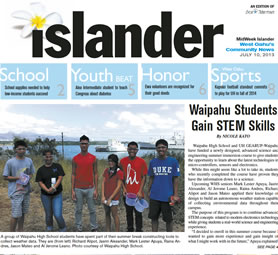Waipahu Students Gain STEM Skills
Waipahu High School and UH GEARUP-Waipahu have funded a newly designed, advanced science and engineering summer immersion course to give students the opportunity to learn about the latest technologies in micro-controllers, sensors and electronics.
While this might seem like a lot to take in, students who recently completed the course have proven they have the information down to a science.
cover_2
Upcoming WHS seniors Mark Lester Apuya, Jasrin Alexander, Al Jerome Leano, Raina Andres, Richard Alipot and Jason Mateo applied their knowledge of design to build an autonomous weather station capable of collecting environmental data throughout their campus.
The purpose of this program is to combine advanced STEM concepts related to modern electronics technology while giving students a real-world science and engineering experience.
“I decided to enroll in this summer course because I wanted to gain more experience and gain insight of what I might work with in the future,” Apuya explained.
During the three-week program, the students assembled a satellite-receiving station that captures radio signals from weather satellites as they orbit the earth every 90 minutes.
“They used a dedicated computer to decode the signal and generate real-time visible and infrared weather images for Hawaii and the Pacific Basin,” explained instructor Lucas Moxey.
“In this way, the students were able to build a comprehensive weather station capable of collecting real-time … data directly from within the classroom and make it available to their community, teachers and scientists via a dedicated website (geostem.com/gearup13).”
The students monitored data autonomously from two locations on campus, collecting light, air temperature, humidity, atmospheric pressure measurements and more. In order to get the needed information, they also created two recording instruments, along with a satellite ground receiving station to complement their local weather information.
“Seeing the final product work made me feel happy,” declared Apuya, “because seeing all that we have accomplished in a short period of time was unbelievable.”
He explained that creating a casing for the device was the most challenging part of the project.
“We needed to create a casing made out of household items that could withstand the weather and would not affect the sensors, as well as the camera,” he said.
Altogether, the project was comprised of four devices for the weather station: base station, remote station, camera and satellite.
“Because of Hawaii’s unique geographic setting, the availability of accessible real-time local weather and regional satellite data can prove invaluable for better understanding and monitoring some of the many natural processes that impact our islands, including severe weather, hurricanes, volcanic eruptions and lava flows,” Moxey said.
“From an education perspective, the opportunity of empowering students to build these instruments from scratch presented (them) with an unsurpassed learning (experience).”







